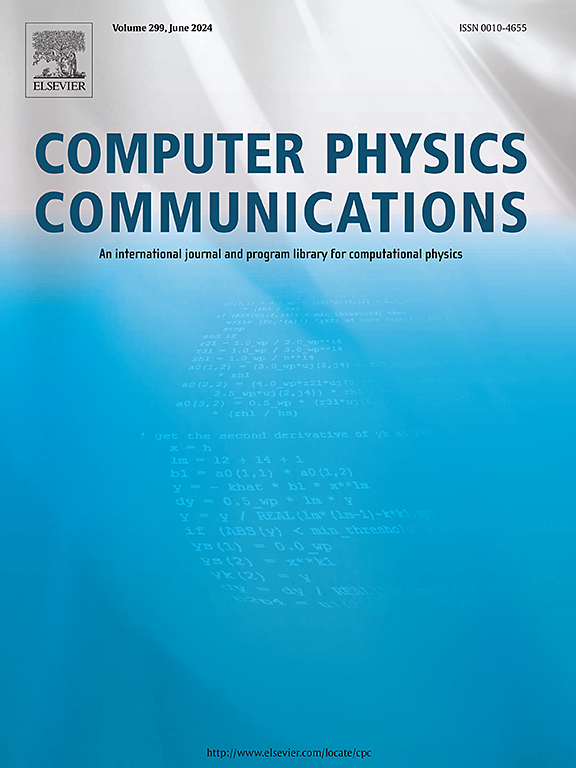A GPU-accelerated numerical model for nearshore scalar transport by dispersive shallow water flows
IF 7.2
2区 物理与天体物理
Q1 COMPUTER SCIENCE, INTERDISCIPLINARY APPLICATIONS
引用次数: 0
Abstract
A GPU-accelerated nearshore scalar transport model with the Boussinesq-type wave solver is introduced. The depth-integrated advection-diffusion equation is implemented into Celeris Advent, the firstly-developed open-source Boussinesq wave model equipped with an interactive system supporting simultaneous visualization and data exchange between a user and the computing unit. A hybrid finite volume-finite difference scheme is adopted to discretize the governing equations, and the modified HLL Riemann solver for satisfying the conservation property of the scalar concentration is applied for an accurate approximation of scalar numerical flux. A source-function wavemaker in conjunction with alongshore periodic boundary conditions and a wave-breaking model are implemented to more precisely replicate the nearshore hydrodynamic processes. Several numerical tests using analytical solutions and experimental data are performed to validate the model. Finally, field-scale dye release experiments are reproduced numerically, assessing the applicability of the proposed model in predicting nearshore scalar transport by dispersive hydrodynamics. The proposed model is expected to serve as an advanced tool for real-time assessment and mitigation of marine pollution incidents.
Program summary
Program Title: Celeris-with-scalar-transport
CPC Library link to program files: https://doi.org/10.17632/bk7v57wsxj.1
Developer's repository link: https://doi.org/10.5281/zenodo.10609197
Licensing provisions: GNU General Public License 3
Programming language: C++, HLSL
Supplementary material: Movies 1-4
Nature of problem: Nearshore scalar transport phenomena have generally been investigated through the numerical models that solve the shallow water equations and the advection-diffusion equation due to their high computational efficiency. However, these models are incapable of simulating the dispersive effects of the waves, which are significant in nearshore hydrodynamics. The scalar transport model with a Boussinesq-type solver can precisely approximate the nearshore scalar transport processes, but its application has been limited by the heavy computational load, which hinders real-time simulations. Building on previous work (Celeris Advent), this software enables real-time numerical simulation of nearshore scalar transport as well as simultaneous visualization. It also supports an interactive environment, allowing the user to change the water surface, bathymetry, and scalar concentration while the model is running.
Solution method: A hybrid finite volume-finite difference scheme is used to solve the extended Boussinesq equations and the advection-diffusion equation. Various components, including the modified HLL Riemann solver, an eddy-viscosity type wave-breaking model, and a source-function wavemaker with periodic boundary conditions, have been newly implemented for better approximations of scalar transport processes governed by breaking dispersive shallow water waves in nearshore regions.
求助全文
约1分钟内获得全文
求助全文
来源期刊

Computer Physics Communications
物理-计算机:跨学科应用
CiteScore
12.10
自引率
3.20%
发文量
287
审稿时长
5.3 months
期刊介绍:
The focus of CPC is on contemporary computational methods and techniques and their implementation, the effectiveness of which will normally be evidenced by the author(s) within the context of a substantive problem in physics. Within this setting CPC publishes two types of paper.
Computer Programs in Physics (CPiP)
These papers describe significant computer programs to be archived in the CPC Program Library which is held in the Mendeley Data repository. The submitted software must be covered by an approved open source licence. Papers and associated computer programs that address a problem of contemporary interest in physics that cannot be solved by current software are particularly encouraged.
Computational Physics Papers (CP)
These are research papers in, but are not limited to, the following themes across computational physics and related disciplines.
mathematical and numerical methods and algorithms;
computational models including those associated with the design, control and analysis of experiments; and
algebraic computation.
Each will normally include software implementation and performance details. The software implementation should, ideally, be available via GitHub, Zenodo or an institutional repository.In addition, research papers on the impact of advanced computer architecture and special purpose computers on computing in the physical sciences and software topics related to, and of importance in, the physical sciences may be considered.
 求助内容:
求助内容: 应助结果提醒方式:
应助结果提醒方式:


